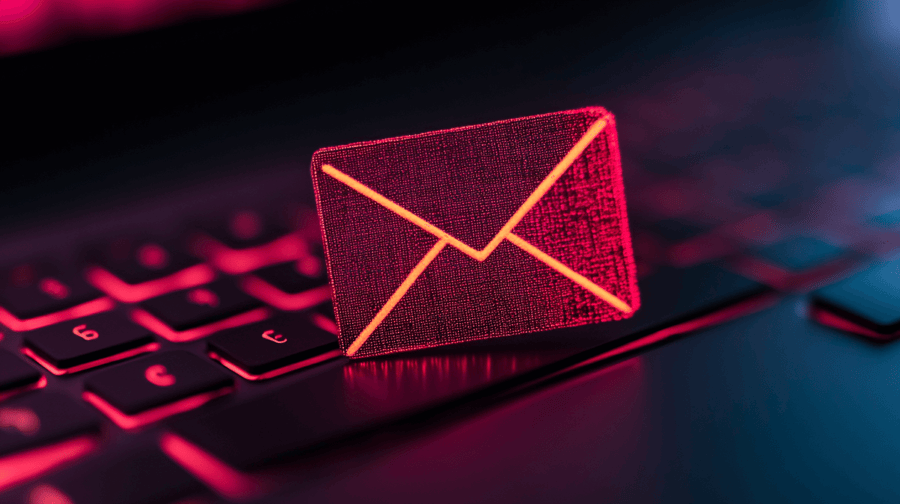Ever felt that unsettling twinge when an email from "your bank" lands in your inbox, asking for sensitive info? You're not alone. Phishing scams have been around for ages, but with artificial intelligence (AI) entering the scene, these scams have levelled up—big time. But don't fret! We're here to guide you through the murky waters of AI-driven phishing and show you how DMARC can be your trusty lifeboat.

The Evolution of Phishing: From Bait to AI-Driven Hooks
Phishing has traditionally been like casting a wide net, hoping to snag a few unsuspecting victims. But now, with AI in the mix, cybercriminals are crafting personalized, convincing emails that are harder to spot than a chameleon in a Skittles factory.
-
AI-Generated Content:
Gone are the days of generic "Dear Customer" emails. Now, AI can scour the internet for information about you and whip up emails that sound like they're from your best friend. For instance, in a recent case, attackers used AI to craft emails that closely mimicked internal communications within a financial institution, making them highly convincing.
-
Deepfake Impersonations:
Imagine receiving a video call from your CEO asking for an urgent fund transfer. With deepfake technology, cybercriminals can create realistic audio and video, making it seem like you're interacting with someone you trust. A notable example involved Italian business leaders, including Giorgio Armani, who were targeted by scammers using AI to mimic the voice of Italy's defense minister, leading to significant financial losses.
-
Increased Attack Volume:
AI doesn't need coffee breaks. It can churn out phishing emails at an alarming rate, flooding inboxes and increasing the chances of a successful scam. For example, Gmail's 2.5 billion users were recently warned about sophisticated AI-driven scams involving fake support calls designed to steal account credentials.
Enter DMARC: Your Email's Knight in Shining Armor
So, how do you protect your business from these cunning attacks? Say hello to DMARC (Domain-based Message Authentication, Reporting, and Conformance). It's a fancy term, but in simple words, DMARC is like a bouncer for your email domain, ensuring only the right folks get in.
Why Should SMBs in South Africa Care About DMARC?
Small to medium-sized businesses (SMBs) are often seen as easy targets by cybercriminals, especially in regions like South Africa where digital infrastructures are still maturing. Here's why implementing DMARC is a game-changer:
-
Enhanced Email Security: DMARC helps prevent unauthorized use of your domain, protecting against phishing and email spoofing attacks.
-
Boosted Brand Trust: When your emails are authenticated, clients and partners can trust that communications from your domain are legitimate.
-
Visibility and Reporting: DMARC provides reports on email authentication activity, offering insights into potential abuse of your domain.

How to Roll Out the DMARC Red Carpet
Ready to give your emails the royal treatment? Here's a step-by-step guide to implementing DMARC:
-
Assess Your Email Environment:
- Identify All Email Sources: List all platforms and services that send emails on behalf of your domain, from internal servers to third-party providers.
-
Set Up SPF and DKIM:
- SPF (Sender Policy Framework): Publish an SPF record in your DNS that specifies authorized mail servers for your domain.
- DKIM (DomainKeys Identified Mail): Implement DKIM to sign your emails, adding a cryptographic signature that verifies the email's authenticity.
-
Publish a DMARC Record:
- Create a DMARC Policy: Decide on a policy ('none', 'quarantine', or 'reject') and publish it as a DNS TXT record.
-
Monitor and Analyze Reports:
- Review DMARC Reports: Regularly analyze DMARC reports to understand authentication results and identify any issues or unauthorized email sources.
-
Gradually Enforce Policy:
- Transition to Stricter Policies: Start with a 'none' policy to monitor, then move to 'quarantine' or 'reject' as you gain confidence in your email authentication setup.
The DIY Dilemma: Navigating DMARC Implementation
Implementing DMARC isn't just about flipping a switch; it's a journey that requires technical know-how and ongoing attention. Many businesses underestimate the complexities involved, leading to potential pitfalls:
-
Time-Consuming Process: Setting up DMARC involves configuring DNS records, aligning SPF and DKIM, and continuous monitoring. Without prior experience, this can be a daunting and lengthy endeavour.
-
Risk of Blocking Legitimate Emails: Misconfigurations can result in legitimate emails being marked as spam or rejected, disrupting business communications.
-
Incompatibility with Cloud-Based Infrastructures: Managing email authentication across multiple cloud services can be challenging, especially when IP addresses change frequently.
The Yolo Advantage:  Expertise at Your Service
Expertise at Your Service
Partnering with a seasoned provider like Yolo can alleviate these challenges. Our team brings a wealth of experience in DMARC implementation, ensuring a smooth transition and ongoing management. By entrusting us with your email security, you can focus on what you do best—running your business—while we handle the intricacies of DMARC, minimizing risks and maximizing deliverability.
Challenges and Considerations for South African SMBs
We get it—implementing new security measures can feel like trying to teach an old dog new tricks. Here are some hurdles you might face and how to leap over them:
-
Resource Constraints: Limited IT resources can make the implementation and ongoing management of DMARC challenging.
-
Awareness and Expertise: A lack of awareness or expertise in email authentication protocols can hinder adoption.
-
Third-Party Email Services: Coordinating DMARC implementation across various third-party email services requires careful planning and collaboration.
Note: This article is based on information from various sources, including industry reports and cybersecurity experts.

Ready to Fortify Your Email Fortress?
Don't wait for a phishing attack to be your wake-up call. At Yolo, we're all about making cybersecurity as breezy as a Sunday afternoon braai. Let us help you navigate the DMARC implementation journey with ease and confidence.